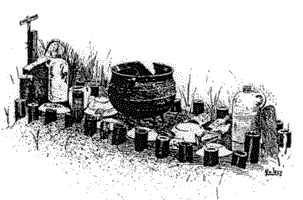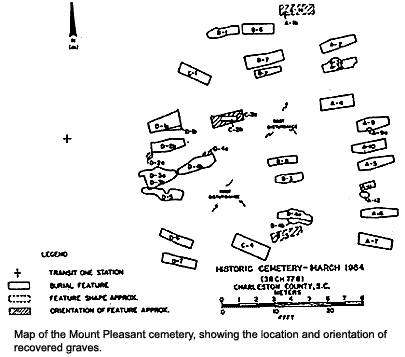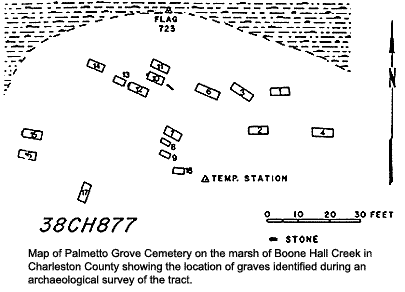South Carolina  SC African-Americans
SC African-Americans  Grave Matters – Introduction
Grave Matters – Introduction
Grave Matters Articles
Introduction to African-American Cemeteries in South Carolina
Archaeology and African-American Cemeteries
History of African-American Cemeteries
Differences between African-American and Euro-American Cemeteries
Preservation of African-American Cemeteries
Additional Resources
African-American Cemeteries in South Carolina
African-American cemeteries are a unique resource. They not only represent the last resting place of black Americans, but they are also storehouses of African-American history. The graveyards and the grave decorations offer an unusual glimpse of a part of history which is rapidly disappearing.
The cultural customs of the people using these cemeteries are quickly changing. In addition, the cemeteries themselves are being lost to development. Sometimes the locations of the cemeteries are not known. Other times, the cemeteries look "abandoned" and "uncared" for.
These articles will help you discover the origins of African-American cemeteries, the beliefs of the people who have used them, and the reasons why they are so important to our understanding of black culture. You can play a vital role in helping to preserve these cemeteries.
Archaeology and African-American Cemeteries
Relatively few African-American cemeteries have been explored archaeologically. There are several reasons for this – many cemeteries dating from the eighteenth or nineteenth century plantations are just never found, others are removed by undertakers without the benefit of archaeological study, and a very few are simply preserved or set aside.
One of the very best studied African-American graveyards in the South Carolina low country was exposed just outside Charleston during the construction of a motel. No archaeological survey had been required, so we aren't sure what above ground indications there might have been. Fortunately, however, the heavy equipment operators did the right thing and stopped when bone was first noticed. Archaeologists and forensic anthropologists were called in and the remains were excavated for study and reburial. While only 36 skeletons were identified, all dated from about 1840 through 1870.
This study helped confirm some of what we know historically and added much to our knowledge of African-American diet and disease. The average age at death for males was a young 35 years, while females lived a few years longer, to about 40. There was evidence among both the males and females of severe dietary stress during childhood, especially during the period from about 2 to 4 years old. Anemia was a significant problem, being found in about 80% of the subadults and over a third of the adults. There were indications of infections in many of the individuals buried at this graveyard. There was likewise clear skeletal evidence of the demanding physical labor these people were forced to undertake. The shoulder and hips were especially affected by degenerative changes. Perhaps most surprisingly, chemical studies also revealed that these African-American slaves were exposed to very high levels of lead in their diet, probably from the ceramics from which they ate.
This cemetery also helped us better understand burial practices among slaves and freedmen shortly after the Civil War. For example, the burials were typically fairly shallow, with none being deeper than perhaps four feet. There was evidence of both coffins and bodies wrapped in shrouds. A large number of coffin hardware items were recovered, including handles, thumbscrews, escutcheons, studs, coffin screws and tacks, and several coffin plates. In fact, at least seven silvered coffin plates were found. Curiously, there is one account of African-American folklore in the Bennett Papers which explains that a "silver coffin-plate with the name of the deceased is believed to confine the spirit of the dead to its proper resting-place to constrain it to remain within the coffin."
Many other graveyards, such as the one at Palmetto Grove, have simply had the identifiable grave depressions mapped, and have been left in place. Since the burials are not removed we don't have the opportunity to learn more about the people who were buried there, but the site is preserved, being set aside. Often, this may be preferable to the community.
© 1996 by Chicora Foundation, Inc. All rights reserved. No part of this publication may be reproduced or transcribed in any form without permissions of Chicora Foundation, Inc. except for brief quotations used in reviews.
This publication was generously supported by a grant from the SC BellSouth Pioneer Volunteers, and we extend our appreciation for their interest in education and preservation. We also wish to acknowledge the use of photographs from the Brookgreen Gardens Archives, Murrells Inlet, South Carolina, and from the South Caroliniana Library, University of South Carolina, Columbia.
Chicora Foundation, Inc
PO Box 8664 • 861 Arbutus Drive
Columbia, South Carolina 29202-8664
803.787.6910


